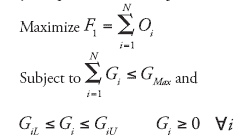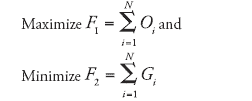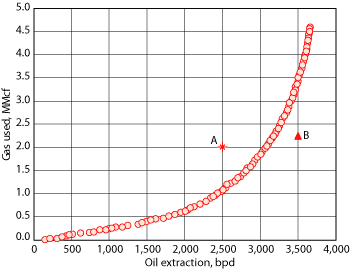A 243-bopd increase on a 56-well problem is seen in computer simulation when an evolutionary algorithm is used with gas lift optimization.
Dr. Tapabrata Ray and Dr. Ruhul Sarker, University of New South Wales
Evolutionary algorithms are a class of stochastic optimization algorithms inspired by the process of natural evolution. They are suitable for complex, real-life optimization problems that have so far been considered intractable. Gas lift is known to be one of the most economic methods for artificially lifting oil.1 This article reports the application of an evolutionary algorithm to find optimal gas injection volumes for oil extraction subject to constraints on gas availability, oil extraction targets and well characteristics. This article also provides insights on the benefits offered by our multi-objective optimization approach, which simultaneously minimizes gas injection while maximizing oil extraction.
Results show significant improvement over existing practices for two standard benchmarks of six-well and 56-well problems. For the six-well problem, the algorithm delivered a solution with 35 bopd more-12,775 bbl improvement on a yearly basis-and for the 56-well problem our solution was better off by 243 bopd-88,695 bbl improvement on a yearly basis-than results previously reported in literature.
BACKGROUND
Oil is a finite and scarce resource which needs to be produced optimally. Evolutionary Algorithms (EA) are one of the frontrunners for optimization methods and tools and have been used extensively in recent years to solve a number of real-life optimization problems.2 Fundamentally, EAs are a class of stochastic optimization methods inspired by nature, where a set of solutions undergo improvements over iterations-often referred to as generations. They are particularly attractive for solving complex nonlinear multi-objective optimization problems where the objective and constraint functions are nonlinear and/or discontinuous, and the users are interested in obtaining a set of tradeoff solutions.
In practice, it is common to collect production data at discrete points for each well-i.e., amount of gas injected and its corresponding volume of oil extraction-and use a piece-wise linear3 or a quadratic function4 to capture their relationship. For a typical well, the volume of oil extraction increases with the amount of gas injected up to a certain level and then decreases. Such behavior-i.e., the limit of safe gas injection/oil extraction volumes-is well specific. As a result, an inappropriate gas allocation to different wells, under limited gas availability, will reduce the overall oil production volume and, hence, profitability from the reservoir.
METHODOLOGY
The above problem can be formulated as a single objective optimization problem such as maximizing oil extraction volume subject to the constraints on total gas availability and limits of safe gas injection volumes into each well. Mathematically, the problem can be represented as:

Where, Oi denotes the volume of oil extracted from the ith well, Gi refers to the amount of gas injected to the ith well, N is the number of wells in the reservoir, GMax represents the total gas availability, and GiL, GiU denote the lower and upper bounds on gas injection volumes into the ith well. For simplicity, we have avoided the functional relationship between Oi and Gi which is nonlinear. However, the interested readers may find the mathematical relationship in work previously published by Ray and Sarker.5 Since the total amount of gas available is likely to vary on a daily basis, the problem can also be formulated as a bi-objective optimization problem as follows:

Subject to the same set of constrains listed above.
We have developed an evolutionary algorithm to solve the above two mathematical programming models. This algorithm is a variant of Nondominated Sorting Genetic Algorithm (NSGA-II)6,7 and has a major difference in the process of population reduction. In the process of population reduction, our method insists on maintaining not only the end points of the objective space but also maximum and minimum values of the variables. Our process is certainly more computationally expensive than NSGA-II and can be thought of as a diversity maintaining mechanism which might be useful for problems where the diversity in the variable space is important. The complete details of the algorithm are outlined in Ray and Sarker’s previous work.5 Further details on multi-objective optimization and evolutionary multi-objective algorithms can be found in a survey paper by Coello Coello.8
CASE STUDIES
The case studies include a six-well problem and a 56-well problem presented in Buitrago et al.9 The gas injection volume versus oil extraction data is interpolated using a piecewise linear function. The maximum injection volumes into each well are limited to 6 MMcf of gas. To establish that the EA could consistently deliver acceptable solutions, 96 independent runs were conducted for each problem with the following set of parameters: population size of 100; generations of 100 and 200; probability of crossover of 0.7 and 0.9; probability of mutation of 0.1 and 0.2; distribution index for crossover as 10 and 20; distribution index of mutation as 10 and 20; and finally, with random seeds of 0.2, 0.4 and 0.6. The average CPU time for an optimization run with a population size of 100 and a generation of 100, which corresponds to evaluation of 10,000 candidate solutions, is around 3.04 seconds on a desktop computer (IBM ThinkCentre: Intel Pentium 4, 2.8 GHz, 1 GB RAM). Source codes were complied using Visual C++ Version 6.0, Enterprise Edition.
For the six-well problem, our best result is around 35 bopd better than those reported by Buitrago et al. and can be seen in Table 1. Also, for the 56-well problem, our best result is around 253 bopd better than those reported by Buitrago et al. The corresponding gas injection volumes are 0.475524996, 0.743445098, 1.350921920, 0.827749079, 1.199584681 and 0.000212049 MMcf, respectively. Since a piecewise linear model has been used in the studies by Buitrago et al., as well as our present EA, the results can be verified using a mixed integer linear programming tool such as LINGO.10 A comparison with LINGO results indicates that our EA is able to locate optimal solutions to the six-well problem with 99% accuracy.
| TABLE 1. Performance of EA on benchmark problems |
 |
|
The results of our multi-objective formulation are shown in Fig. 1, which is particularly useful for planning, as it provides direct information on the minimum amount of gas required to achieve any given oil extraction target, and eliminates the need to resolve single-objective optimization problems on a daily basis with differing total gas availability figures. It is clear from Fig. 1 that point A-i.e., a 2,500-bopd extraction with 2 MMcf-is possible to achieve whereas point B, which requires 3,500-bopd extraction with 2.25 MMcf, is not achievable. If we need to deliver 3,500 bopd, a minimum of 3.5 MMcf of gas would be necessary.
 |
|
Fig. 1. Solutions to the multi-objective formulation of the six-well problem.
|
|
CONCLUSIONS
In this article we have introduced a practical gas lift optimization problem and solved the single and multi-objective versions of the problem using our multi-objective evolutionary algorithm. For both the six-well and the 56-well problems, our method yielded better results than that of previous reports. We have also extended our study to include the results of multi-objective formulations of the problem to highlight some of the additional benefits that can be derived using our multi-objective evolutionary algorithm. The consistency and the efficiency of our algorithm have been demonstrated through multiple runs. Our multi-objective approach is attractive as it eliminates the need to solve gas lift optimization problems on a daily basis. Our surrogate-assisted approach allows oil extraction versus gas usage data to be approximated using nonlinear functions to represent real life instances more closely. Additional constraints or objectives can be handled seamlessly using the proposed approach. 
LITERATURE CITED
1 Ayatollahi, S., Narimani. M. and M. Moshfeghian, “Intermittent gas lift in Aghajari Oil Field, a mathematical study,” Journal of Petroleum Science and Engineering, 42, 2004, pp. 245-255.
2 Goldberg, D., Genetic Algorithms: In Search, Optimisation and Machine Learning. Addison Wesely, 1989.
3 Kosmidis, V., Perkins, J. and E. Pistikopoulos, “A mixed integer optimization formulation for the well scheduling problem on petroleum fields,” Computers and Chemical Engineering, 29, 2005, pp. 1523-1541.
4 Camponogara, E. and P. Nakashima, “Optimization of lift-gas allocation using dynamic programming,” IEEE Transactions on Systems, Man and Cybernetics - Part A: Systems and Humans, 36, 2006, pp. 407-414.
5 Ray, T. and R. Sarker, “Genetic algorithm for solving a gas lift optimization problem,” Journal of Petroleum Science and Engineering, Vol. 59, 2007, pp. 84-96.
6 Deb. K., Pratap, A., Agarwal, S. and T. Meyarivan, “A fast and elitist multi-objective genetic algorithm: NSGAII,” IEEE Transaction on Evolutionary Computation, 6, 2002, pp. 181-197.
7 Deb. K., Pratap, A., Agarwal, S. and T. Meyarivan, “A fast elitist nondominated sorting genetic algorithm for multi-objective optimization: NSGAII,” Proceedings of the Parallel Problem Solving from Nature VI Conference, Paris, France, 2000, pp. 849-858.
8 Coello Coello, C., “A comprehensive survey of evolutionary-based multi-objective optimization techniques,” Knowledge and Information Systems, 1, No. 3, 1999, pp. 269-308.
9 Buitrago, S., Rodriguez, E. and D. Espin, “Global optimization techniques in gas allocation for continuous flow gas lift systems,” SPE35616, presented at the SPE Gas Technology Conference, Calgary, Canada, 1996.
10 LINGO, 1999. Lingo System Inc., http://www.lindo.com
|
THE AUTHORS
|
|
|
Tapabrata Ray earned his PhD in Ocean Engineering and Naval Architecture from Indian Institute of Technology Kharagpur. He is presently a senior lecturer with the School of Aerospace, Civil and Mechanical Engineering, University of New South Wales, Canberra, Australia. Ray has published more than 80 technical papers in multidisciplinary design optimization, robust design and surrogate modeling.
|
|
|
|
Ruhul Sarker earned his PhD in Operations Research from DalTech (former TUNS), Dalhousie University, Canada. He is presently a senior lecturer in the School of IT&EE, University of New South Wales, Canberra, Australia. His main research areas are applied operations research and evolutionary optimization. Sarker has published more than 140 technical papers and is the lead author of Optimization Modeling: A Practical Approach published by Taylor and Francis.
|
|
|








